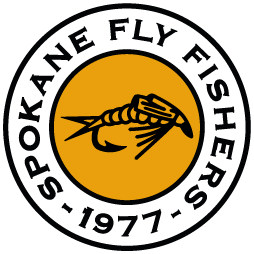Another Wonderful Donation! In what is becoming a trend, our library has received another wonderful donation. These donations have helped update our collection with newer volumes. One such is the second edition of Landon Mayer’s Sight Fishing for Trout. With a copyright of 2019, it is about as new as a donated volume can be. The reader would expect, given the recent issuance, that such a volume would display state-of-the-art photography and other artwork, as well as the newest in discussions of techniques and equipment. Sight Fishing… doesn’t disappoint. The color photography is wonderfully detailed and fascinating. There is a fair share of “fish porn,” tastefully done, to excite the reader without being offensive. In fact, almost all the fish shots are of a quality that allows the reader to enjoy the individual traits found in trout – spotting, various shapes and sizes of kypes, differences between individual fish in spawning garb and full fighting form. What these photos really do is reinforce the author’s message that proper sight fishing techniques, when applied, yield much finer catches. Indeed, if one can apply all the techniques described, I have no doubt that one’s catches would substantially improve in number and quality.
The reader doesn’t get too far along before she/he realizes that this author is serious about his topic! I have not seen such an emphasis on stealth and camouflage since The Curtis Creek Manifesto. Photographs of anglers (even youngsters) bent at the waist, peering from behind rocks and other cover, reinforce the authors emphasis on stalking. Likewise, there is also emphasis on searching the water carefully… no, I mean really carefully… prior to approaching for the cast. The author, in the chapter on “The Buddy System,” recommends working as a team, with one angler locating and watching individually targeted fish from an elevated or sheltered position while his buddy casts and works the fly according to the fish’s movements, as called out by the spotter. Indeed, the author indicates a preference for this kind of fishing over fishing alone. As already stated, Mayer is nothing if not serious! As nice as the photography is, I found some of it to be a bit tricky. There are pictures of fish sighted from the bank or from an overlook in moving or rippled water. These photos are well done in that they are unfocused and one has to strain to find the fish in them, just as one would (or, at least I would) have to on the bank of a stream or lake. In fact, I am still looking for the fish in several of them! But, then, that is probably the idea behind these photos. Studying these pictures to locate the fish is part of the enjoyment of reading this volume. Sight Fishing for Trout is not limited to visual location and stalking. There are separate chapters on dry-fly fishing, nymphing, and streamer presentation, with a few of the author’s favorite recipes for each. There is a section on various types of casts. The portion describing rise forms might rival the observations in Vince Marinaro’s In the Ring of the Rise. In particular, the chapter entitled “Tools for the Hunt” reads something like a field manual for military commando operations! It contains fine discussion of the equipment (sunglasses, hooded apparel, in colors that match the background behind the angler) needed for the successful, stealthy approach and attack. (Did I really say attack? Well, the intensity of the author leads toward such verbiage…)
One bit of serious advice: Do not proceed through this volume without reading the forwards. The forward, by John Randolph, to the first edition is repeated here. Even more importantly, the forward to this second edition, by Ed Engle, is particularly insightful and helps the reader understand the intensity of the author. As Engle notes, “…it’s the best way I know for you to speed up your learning curve when it comes to angling intricacies of spring creeks and tailwaters. You’ll still need to spend time on the water, but if quitting your day job isn’t an option, studying Sight Fishing for Trout is as close as you can get to adding extra days on the River.”
This wonderful volume is now available through your SFF Library.
